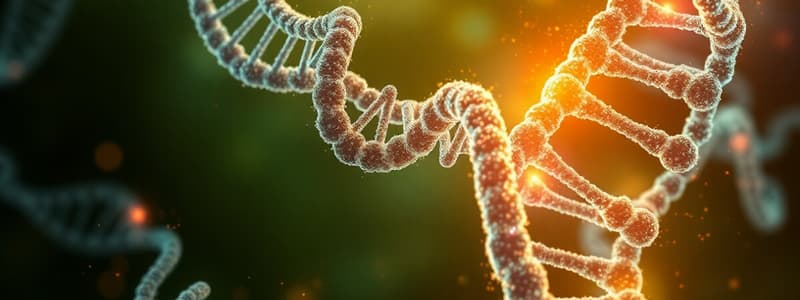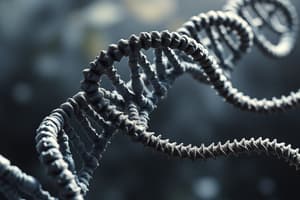Podcast
Questions and Answers
What sugar is found in DNA?
What sugar is found in DNA?
- Deoxyribose (correct)
- Ribose
- Fructose
- Glucose
Which of the following bases are classified as purines?
Which of the following bases are classified as purines?
- Thymine and Uracil
- Adenine and Guanine (correct)
- Cytosine and Thymine
- Adenine and Cytosine
What is the role of the promoter region in a gene?
What is the role of the promoter region in a gene?
- It controls gene expression. (correct)
- It codes for proteins.
- It holds nitrogenous bases.
- It provides energy for transcription.
What determines the phenotype of an organism?
What determines the phenotype of an organism?
Which of these represents the relationship between alleles and dominance?
Which of these represents the relationship between alleles and dominance?
How many protein-coding genes do humans have approximately?
How many protein-coding genes do humans have approximately?
Where does the process of transcription occur?
Where does the process of transcription occur?
What are the observable traits that genes are responsible for expressing?
What are the observable traits that genes are responsible for expressing?
Where are genes located in prokaryotic cells?
Where are genes located in prokaryotic cells?
Which components make up a nucleotide?
Which components make up a nucleotide?
What are introns in the context of gene structure?
What are introns in the context of gene structure?
How does the gene structure in eukaryotic cells differ from that in prokaryotic cells?
How does the gene structure in eukaryotic cells differ from that in prokaryotic cells?
What structure forms when DNA is compacted around histones in eukaryotic cells?
What structure forms when DNA is compacted around histones in eukaryotic cells?
What percentage more genes do bananas possess compared to humans?
What percentage more genes do bananas possess compared to humans?
What type of bonds connect the base pairs in the double helix structure of DNA?
What type of bonds connect the base pairs in the double helix structure of DNA?
Flashcards
Gene
Gene
The basic unit of inheritance, located on a chromosome at a specific position (locus).
Gene Expression
Gene Expression
The process by which a gene's information is used to create a protein.
Gene Locus
Gene Locus
The specific location of a gene on a chromosome.
Eukaryotic Gene Location
Eukaryotic Gene Location
Signup and view all the flashcards
Prokaryotic Gene Location
Prokaryotic Gene Location
Signup and view all the flashcards
DNA Nucleotide
DNA Nucleotide
Signup and view all the flashcards
Exon
Exon
Signup and view all the flashcards
Intron
Intron
Signup and view all the flashcards
Deoxyribose
Deoxyribose
Signup and view all the flashcards
Purines
Purines
Signup and view all the flashcards
Pyrimidines
Pyrimidines
Signup and view all the flashcards
Gene Promoter
Gene Promoter
Signup and view all the flashcards
Alleles
Alleles
Signup and view all the flashcards
Dominant Allele
Dominant Allele
Signup and view all the flashcards
Transcription
Transcription
Signup and view all the flashcards
Study Notes
Gene Definition and Structure
- Genes are the fundamental units of heredity located at specific positions (loci) on chromosomes.
- They dictate the expression of observable traits (phenotype) by directing protein synthesis.
- Gene location varies between eukaryotic and prokaryotic cells. Eukaryotic genes are in the nucleus, mitochondria and chloroplasts (in plants), while prokaryotic genes are located on a single chromosome in the cytoplasm.
- Organisms have varying numbers of genes. Humans have approximately 20,000, while bananas have 30,000 (50% more).
- Genes are encoded within DNA strands.
- DNA is a double helix composed of nucleotide monomers (deoxyribose sugar, phosphate group, and one of four nitrogenous bases: A, T, C, or G).
- Adenine pairs with thymine (A-T), and guanine pairs with cytosine (G-C) via hydrogen bonds. This antiparallel pairing is crucial for DNA replication.
- Gene sequences include protein-coding regions (exons) and non-coding regions (introns). Introns are interspersed repetitive sequences, while exons specify protein construction.
Gene Structure Differences
- Eukaryotic genes are found within long DNA strands condensed in the nucleus, wound around histones to form nucleosomes.
- Prokaryotic genes are typically clustered in operons, working together to regulate gene function. They lack the significant intronic regions found in eukaryotes.
Gene Components
-
Chemical Components: DNA consists of nucleotides, which are made of sugar, a nitrogenous base (purine or pyrimidine), and a phosphate group.
-
In DNA, the sugar is deoxyribose. Purines include A and G, having a double-ring structure. Pyrimidines include C and T, having a single ring.
-
Sugar-phosphate backbones form the DNA strand's structure and nitrogenous bases form hydrogen bonding for the double-helix formation, determined by the sequence of A, T, C, and G, governing gene function.
-
Functional Components: Genes contain a promoter region and a coding region.
-
The promoter, located upstream of the coding region, controls gene expression timing and location. This tissue-specific gene expression explains, for instance, why digestive genes are not present in eye tissue.
-
The promoter, and other cis-acting elements (enhancers), are nucleotide sequences situated either near (promoter) or farther away from (enhancer) the coding sequence to control gene activity.
-
Trans-acting elements, proteins in the nucleus, also control gene expression.
How Genes Work
- Genes provide instructions for protein formation.
- Transcription: Enzymes produce complementary mRNA from DNA.
- Translation: Ribosomes produce proteins from the mRNA code.
- Proteins are the building blocks of life and carry out various functions, thus observable traits (phenotype) are directly controlled by the genes.
- The Human Genome Project (completed in 2003) elucidated the human genome, and indicated approximately 20,000 protein-coding genes.
- Each gene usually exists in two copies (one from each parent). These copies—alleles—may have different nucleotide sequences.
- Allele expression is governed by dominance patterns. A dominant allele will mask the expression of a recessive allele, barring the expression of recessive alleles from expressing if the dominant allele is present. For example, the brown eye color allele ("B") is dominant over blue eye color allele ("b"). Only the homozygous recessive "bb" genotype will result in blue eyes.
Studying That Suits You
Use AI to generate personalized quizzes and flashcards to suit your learning preferences.




